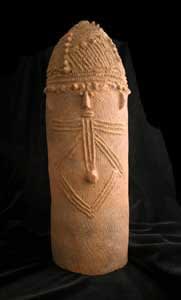Bura Conical Vessel with a Face, 3rd Century CE - 11th Century CE
Terracotta
23
PF.5488
In 1975, a young man by chance found two clay heads. He gave them to his children to play with and not until three years later did the Department of...
In 1975, a young man by chance found two clay heads. He gave them to his children to play with and not until three years later did the Department of Art and Archaeology learn about this find (luckily there was still one of the heads left). Later excavations uncovered several gravesites along both banks of the Niger River, the geographical divider between the modern nations of Niger and Burkina Faso. In the grave complexes, various terracotta works were found and assigned to the 3rd-11th centuries. This phallically designed, conical receptacle is richly ornamented with raised patterns perhaps imitating ritual scarification or elaborate textile motifs. Vessels such as this one were discovered buried with their opening down, allegedly filled with clothes and belongings of the deceased that they might find necessary in the afterlife. Surely the symbolic power of the form is evident. Perhaps this receptacle also related to notions of fertility in the afterlife and rebirth in the next world. The stylized features of the face are minimized compared to the size of the vessel. The small eyes, arched nose, and pursed lips are characteristic of the Bura style and can be seen on other smaller figures found entombed alongside these vessels. This fascinating work is a relic of a lost civilization. Demonstrating their extraordinary artistic vision, this receptacle also hints at their religious and spiritual beliefs. Alas, this fragile terracotta sculpture is the last echo of a civilization’s voice sounded almost a thousand years before.
